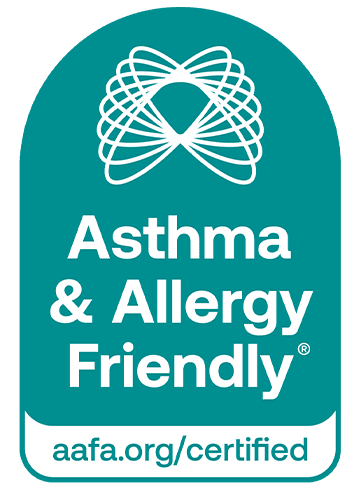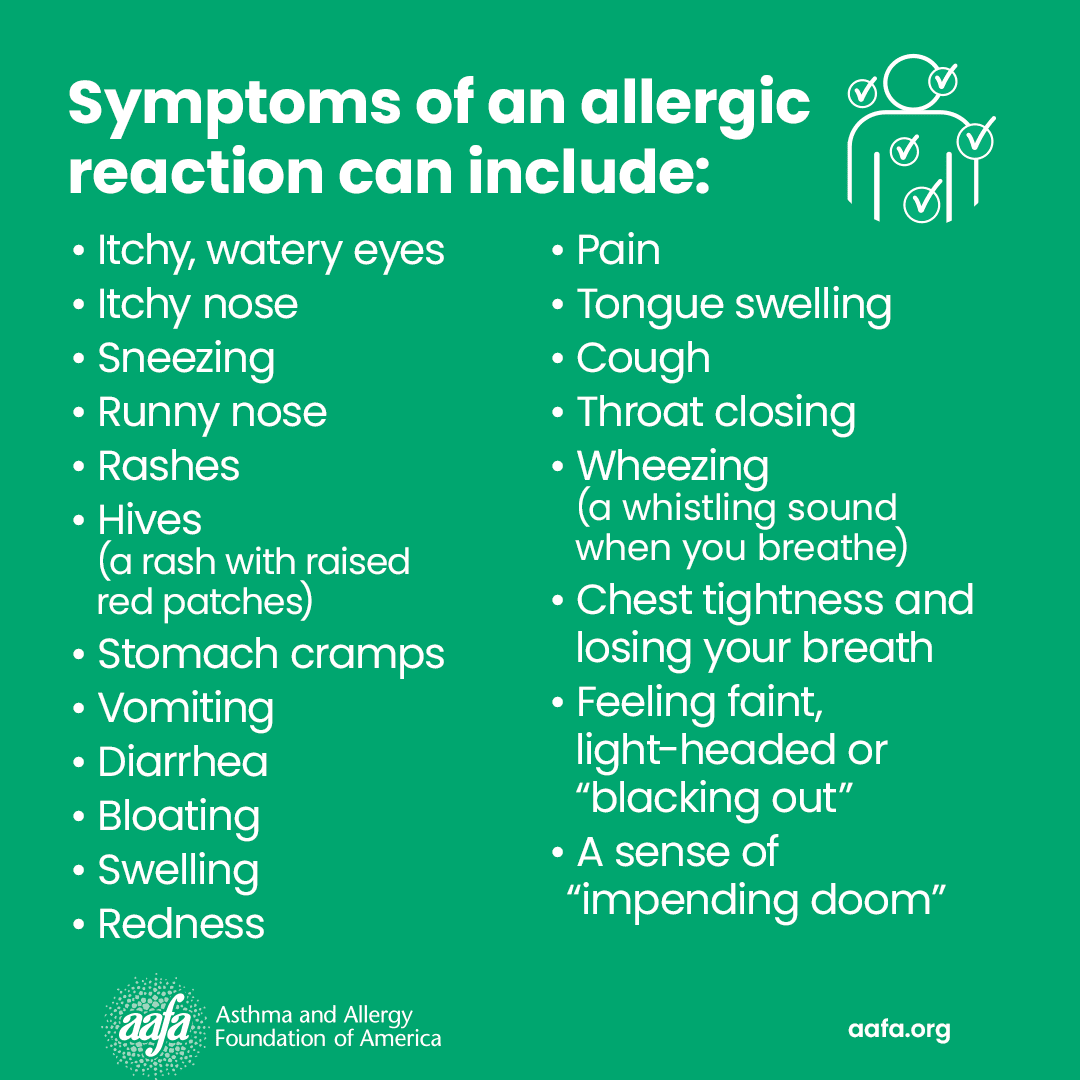Allergies
Nasal Allergies (Rhinitis)
Mucus usually drains down the back of your throat. You’re not aware of this most of the time because it is a small amount and is thin. When the nose becomes irritated, it may produce more mucus, which becomes thick and pale yellow. The mucus may begin to flow from the front of the nose as well as the back. Substances in the mucus may irritate the back of the throat and cause coughing. Postnasal drip occurs when more mucus drains down the back of the throat.
What Causes Rhinitis?
Irritants or allergens (substances that provoke an allergic response) may cause rhinitis. The cells of your body react to these irritants or allergens by releasing histamine and other chemicals. Rhinitis is often a temporary condition. It clears up on its own after a few days for many people. In others, especially those with allergies, rhinitis can be a chronic problem. Chronic means it is almost always present or recurs often. Rhinitis can last for weeks to months with allergen exposure.
What Are the Types of Rhinitis?
There are several types of rhinitis:
- Allergic rhinitis is caused by allergies to substances called allergens.
- Seasonal allergic rhinitis is sometimes called “hay fever.” But, people with seasonal allergic rhinitis do not have to have a fever and do not have to be exposed to hay to develop this condition. It is an allergic reaction to pollen from trees, grasses and weeds. This type of rhinitis occurs mainly in the spring and fall, when pollen from trees, grasses and weeds are in the air.
- Perennial allergic rhinitis is caused by allergens that are present all year long. The primary causes of this type of rhinitis are allergies to dust mites, mold, animal dander and cockroach debris.
- Non-allergic rhinitis is not caused by allergens. Smoke, chemicals or other irritating environmental conditions may provoke non-allergic rhinitis. Hormonal changes, physical defects of the nose (like a deviated septum) and the overuse of nose sprays may also cause it. Sometimes medications cause it. Often, the cause of this type of rhinitis is not well understood. But it is common in patients with non-allergic asthma. The symptoms are similar to allergy symptoms.
- Infectious rhinitis is possibly the most common type of rhinitis. It is also known as the common cold or upper respiratory infection (URI). Colds occur when a cold virus settles into the mucous membranes of the nose and sinus cavities and causes an infection.
What Are the Symptoms of Rhinitis?
Rhinitis symptoms include:
- Itching in the nose and eyes
- Sneezing
- Stuffy nose (congestion)
- Runny nose
- Mucus (phlegm) in the throat (postnasal drip)
Is It Allergies or a Cold?
Sometimes it can be hard to tell the difference between allergies and the common cold. There are more than a hundred strains of cold viruses. Each tends to become widespread at certain times of the year, which is why you may mistake a cold for a seasonal allergy. Allergies occur at the same time every year and last as long as the allergen is in the air (usually 2-3 weeks per allergen). Allergies cause itching of the nose and eyes along with other nasal symptoms. Colds last about one week and have less itching of the nose and eyes.
What Are the Treatments for Allergic Rhinitis?
The first and best option is to avoid contact with substances that trigger your nasal allergies (allergens). When prevention is not enough, consider using over-the-counter or prescription medicines. See our “Allergy Medicine Guide” below.
Nasal allergy symptoms may disappear completely when the allergen is removed or after the allergy is treated. Talk with your pharmacist and health care provider about what is best for you.
Many people with allergies do not get complete relief from medicines. They may be candidates for immunotherapy. Immunotherapy is a long-term treatment that can help prevent or reduce the severity of allergic reactions and change the course of allergic disease by modifying the body’s immune response to allergens.
Allergy Medicine Guide
Nasal rinse: Using a saline (saltwater) nose rinse can help cut down mucus and rinse allergens out of your nose. Remember to use these as directed.
Nose sprays: Corticosteroid nose sprays are effective and have few side effects. They treat the swelling and inflammation in your nose. (Examples include Nasacort®, FLONASE®, and RHINOCORT®.) Antihistamine nasal sprays such as Astelin and Patanase are also effective options.
Eye drops: Allergy eye drops can be very helpful in managing eye allergy symptoms. They can relieve burning sensation, itchiness, redness, increased tearing, and swelling. Common eye drops include SYSTANE® ZADITOR®, Optivar, and Pataday®. In addition, artificial tears can be helpful.
Antihistamines: Antihistamines come in pill, liquid, or nasal spray form. They can relieve sneezing and itching in the nose and eyes. They also reduce a runny nose and, to a lesser extent, nasal stuffiness. Look for a long-acting, non-drowsy antihistamine. (Examples include ZYRTEC®, Claritin®, Allegra®, CLARINEX®.)
Decongestants: Decongestants are available as pills, liquids, nasal sprays, or drops. They help shrink the lining of the nasal passages and relieve stuffiness. They generally are only used for a short time (usually three days or less – examples include SUDAFED®, Vicks Sinex™, Afrin®). Check with your doctor before using decongestants if you have high blood pressure, glaucoma, thyroid disease, or trouble urinating.
Leukotriene modifiers (such as montelukast): This medicine can help by blocking chemicals your body releases when you have an allergic reaction. (Examples include SINGULAIR®, Zyflo CR®, ACCOLATE®.)
Note: Montelukast (brand name SINGULAIR®) has a black box warning. This is a safety warning from the Food and Drug Administration (FDA). This means you need to be aware of a drug’s side effects or important instructions for safe use of the drug. We encourage you to speak with your health care provider before, during, and after the start of any new medicine. If your doctor recommends montelukast, talk with them about possible risks and concerns.
Cromolyn sodium: This is a nasal spray that blocks the release of chemicals that cause allergy symptoms, including histamine and leukotrienes. This medicine has few side effects, but you must take it four times a day. (Examples include NasalCrom®)
How Can I Prevent Allergic Rhinitis?
The first and best option is to avoid contact with allergens. Other prevention tips are:
- Don’t touch or rub your nose.
- Wash your hands often with soap and water.
- Use a vacuum with a CERTIFIED asthma & allergy friendly® filter to reduce allergen exposure while vacuuming.
- Wash your bed linens and pillowcases in hot water and detergent to reduce allergens.
- Use dust-mite proof covers for pillows, comforters, duvets, mattresses and box springs.
- Keep pets out of the bedroom to reduce pet dander allergen in your bedding.
- Wear sunglasses and a wide-brimmed hat to reduce pollen getting into your eyes.
- Keep windows closed during high pollen and mold seasons. Use the air conditioner in your car and home (CERTIFIED asthma & allergy friendly® filter).
Medical Review October 2015.
Allergy Capitals
Your location can have an impact on your seasonal allergies. AAFA’s Allergy Capitals™ report looks at the top 100 most challenging cities in the continental United States to live with seasonal pollen allergies.










 Vacuum Cleaners for Allergies
Vacuum Cleaners for Allergies


